Acura TSX 2012 Owner's Manual
Manufacturer: ACURA, Model Year: 2012, Model line: TSX, Model: Acura TSX 2012Pages: 324, PDF Size: 9.45 MB
Page 291 of 324

290Handling the Unexpected
Indicator, Coming On/BlinkingIf the Low Oil Pressure Indicator Comes On
■
Reasons for the indicator to come on
Comes on when the engine oil pressure is low.
■
What to do as soon as the indicator comes on
1.Immediately park the vehicle in a safe place.
2.If necessary, turn the hazard warning lights on.
■
What to do after parking the vehicle
1.Stop the engine and let it sit for about one minute.
2.Open the hood and check the oil level.
uAdd oil as necessary.
3.Start the engine and check the low oil pressure indicator.
uThe light goes out: Start driving again.
uThe light does not go out within 10 seconds: Stop the engine and
contact a dealer for repairs immediately.
If the Charging System Indicator Comes On
■
Reasons for the indicator to come on
Comes on when the battery is not being charged.
■
What to do when the indicator comes on
Turn off the climate control system, rear defogger, and other electrical
systems, and immediately contact a dealer for repairs.
1If the Low Oil Pressure Indicator Comes On
NOTICERunning the engine with low oil pressure can cause
serious mechanical damage almost immediately.1If the Charging System Indicator Comes On
If you need to stop temporarily, do not turn off the
engine. Restarting the engine may rapidly discharge
the battery.
Page 292 of 324
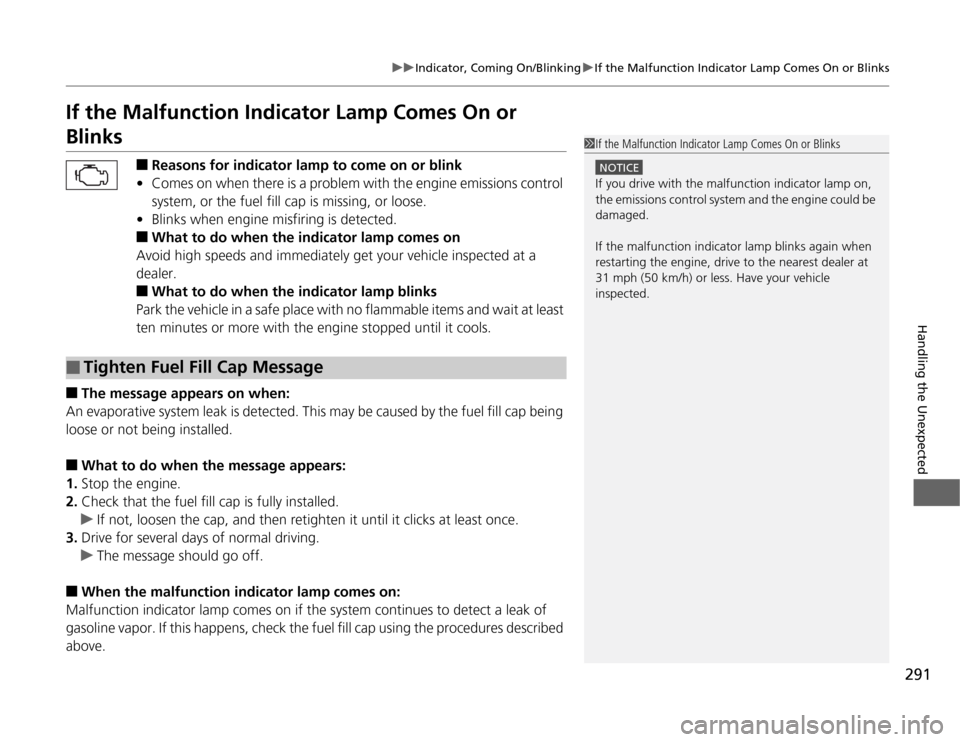
291
uuIndicator, Coming On/BlinkinguIf the Malfunction Indicator Lamp Comes On or Blinks
Handling the Unexpected
If the Malfunction Indicator Lamp Comes On or Blinks
■
Reasons for indicator lamp to come on or blink
•Comes on when there is a problem with the engine emissions control
system, or the fuel fill cap is missing, or loose.
•Blinks when engine misfiring is detected.
■
What to do when the indicator lamp comes on
Avoid high speeds and immediately get your vehicle inspected at a
dealer.
■
What to do when the indicator lamp blinks
Park the vehicle in a safe place with no flammable items and wait at least
ten minutes or more with the engine stopped until it cools.
■
The message appears on when:
An evaporative system leak is detected. This may be caused by the fuel fill cap being
loose or not being installed.
■
What to do when the message appears:
1.Stop the engine.
2.Check that the fuel fill cap is fully installed.
uIf not, loosen the cap, and then retighten it until it clicks at least once.
3.Drive for several days of normal driving.
uThe message should go off.
■
When the malfunction indicator lamp comes on:
Malfunction indicator lamp comes on if the system continues to detect a leak of
gasoline vapor. If this happens, check the fuel fill cap using the procedures described
above.
■
Tighten Fuel Fill Cap Message
1If the Malfunction Indicator Lamp Comes On or Blinks
NOTICEIf you drive with the malfunction indicator lamp on,
the emissions control system and the engine could be
damaged.
If the malfunction indicator lamp blinks again when
restarting the engine, drive to the nearest dealer at
31 mph (50 km/h) or less. Have your vehicle
inspected.
Page 293 of 324

292
uuIndicator, Coming On/BlinkinguIf the Brake System Indicator Comes On
Handling the Unexpected
If the Brake System Indicator Comes On
■
Reasons for the indicator to come on
•The brake fluid is low.
•There is a malfunction in the brake system.
■
What to do when the indicator comes on while driving
Press the brake pedal lightly to check pedal pressure.
•If normal, check the brake fluid level the next time you stop.
•If abnormal, take immediate action. If necessary, downshift the
transmission to slow the vehicle using engine braking.
If the EPS Indicator Comes On
■
Reasons for the indicator to come on
•Comes on when there is a problem with EPS.
•If you depress the accelerator pedal repeatedly to increase the engine
speed while the engine is idling, the indicator comes on, and
sometimes the steering wheel becomes harder to operate.
■
What to do when the indicator comes on
Stop the vehicle in a safe place and restart the engine.
If the indicator comes on and stays on, immediately have your vehicle
inspected by a dealer.
1If the Brake System Indicator Comes On
Have your vehicle repaired immediately.
It is dangerous to drive with low brake fluid. If there
is no resistance from the brake pedal, stop
immediately in a safe place. If necessary downshift
the gears.
If the brake system indicator and ABS indicator come
on simultaneously, the brake distribution system is
not working. This can result in vehicle instability
under sudden braking.
Have your vehicle inspected by a dealer immediately.
U.S.
Canada
1If the EPS Indicator Comes On
NOTICEIf you repeatedly turn the steering wheel at an
extremely low speed, or hold the steering wheel on
the full left or right position for a while, the system
heats up. The system goes into a protective mode,
and limits its performance. The steering wheel
becomes harder and harder to operate. Once the
system cools down, EPS is restored. Repeated
operation under these conditions can eventually
damage the system.
Page 294 of 324
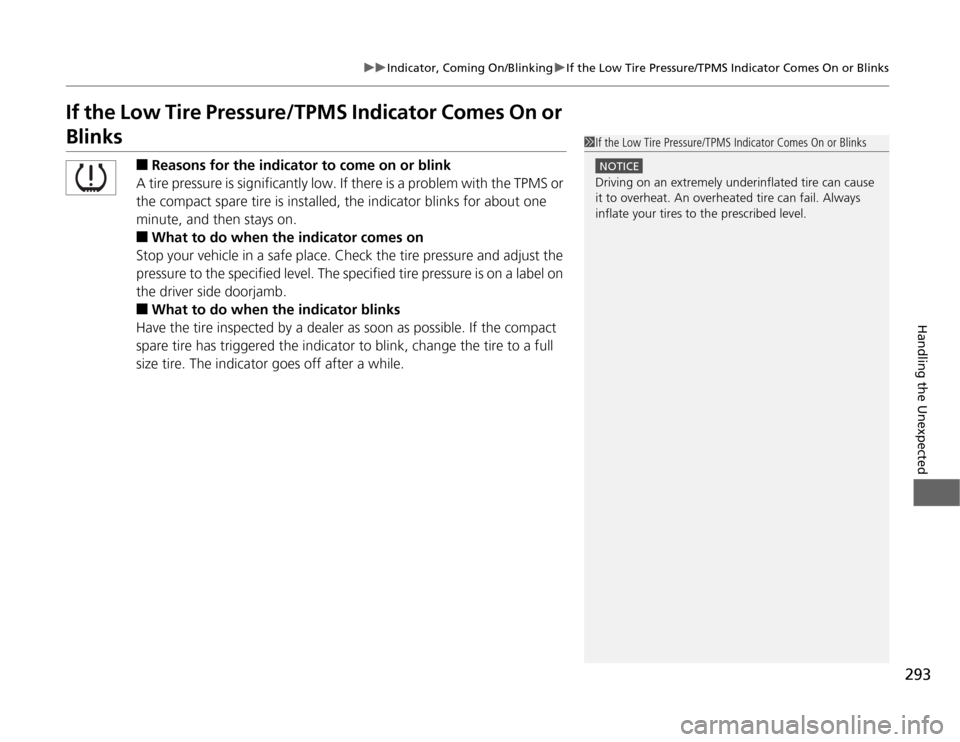
293
uuIndicator, Coming On/BlinkinguIf the Low Tire Pressure/TPMS Indicator Comes On or Blinks
Handling the Unexpected
If the Low Tire Pressure/TPMS Indicator Comes On or Blinks
■
Reasons for the indicator to come on or blink
A tire pressure is significantly low. If there is a problem with the TPMS or
the compact spare tire is installed, the indicator blinks for about one
minute, and then stays on.
■
What to do when the indicator comes on
Stop your vehicle in a safe place. Check the tire pressure and adjust the
pressure to the specified level. The specified tire pressure is on a label on
the driver side doorjamb.
■
What to do when the indicator blinks
Have the tire inspected by a dealer as soon as possible. If the compact
spare tire has triggered the indicator to blink, change the tire to a full
size tire. The indicator goes off after a while.
1If the Low Tire Pressure/TPMS Indicator Comes On or Blinks
NOTICEDriving on an extremely underinflated tire can cause
it to overheat. An overheated tire can fail. Always
inflate your tires to the prescribed level.
Page 295 of 324
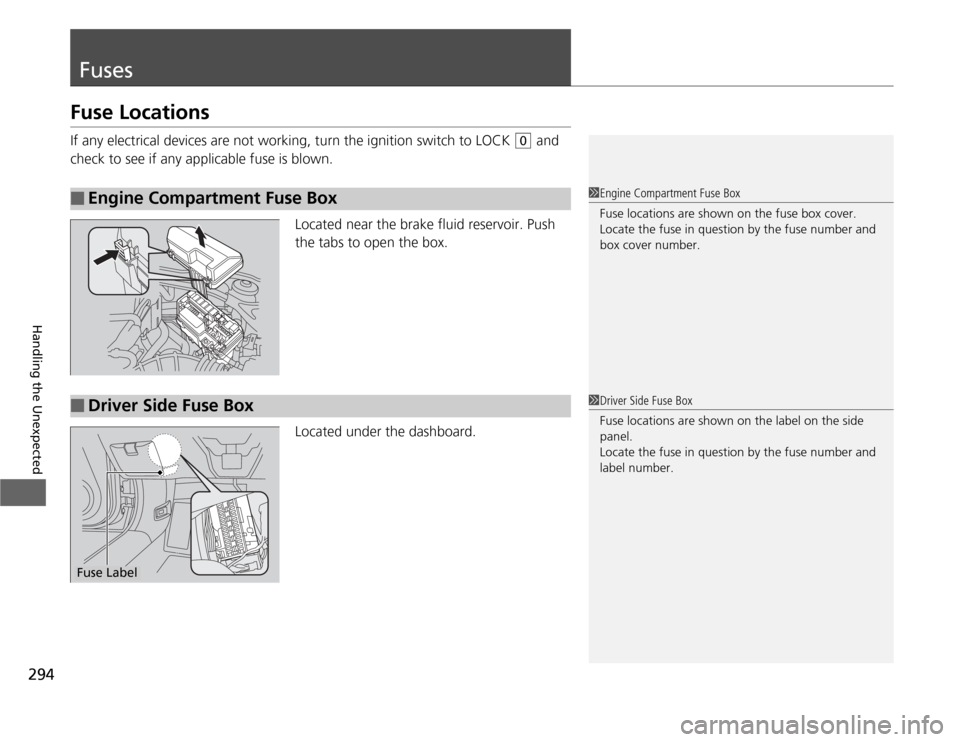
294Handling the Unexpected
FusesFuse LocationsIf any electrical devices are not working, turn the ignition switch to LOCK
(0
and
check to see if any applicable fuse is blown.
Located near the brake fluid reservoir. Push
the tabs to open the box.
Located under the dashboard.
■
Engine Compartment Fuse Box
1Engine Compartment Fuse Box
Fuse locations are shown on the fuse box cover.
Locate the fuse in question by the fuse number and
box cover number.
■
Driver Side Fuse Box
1Driver Side Fuse Box
Fuse locations are shown on the label on the side
panel.
Locate the fuse in question by the fuse number and
label number.
Fuse Label
Page 296 of 324
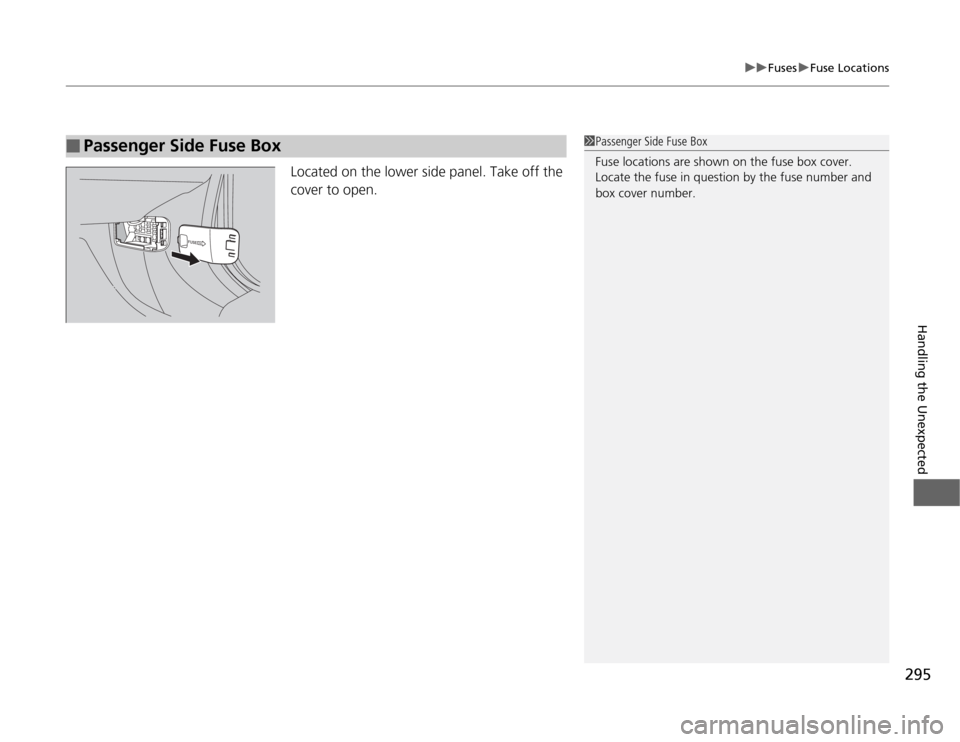
295
uuFusesuFuse Locations
Handling the Unexpected
Located on the lower side panel. Take off the
cover to open.
■
Passenger Side Fuse Box
1Passenger Side Fuse Box
Fuse locations are shown on the fuse box cover.
Locate the fuse in question by the fuse number and
box cover number.
Page 297 of 324
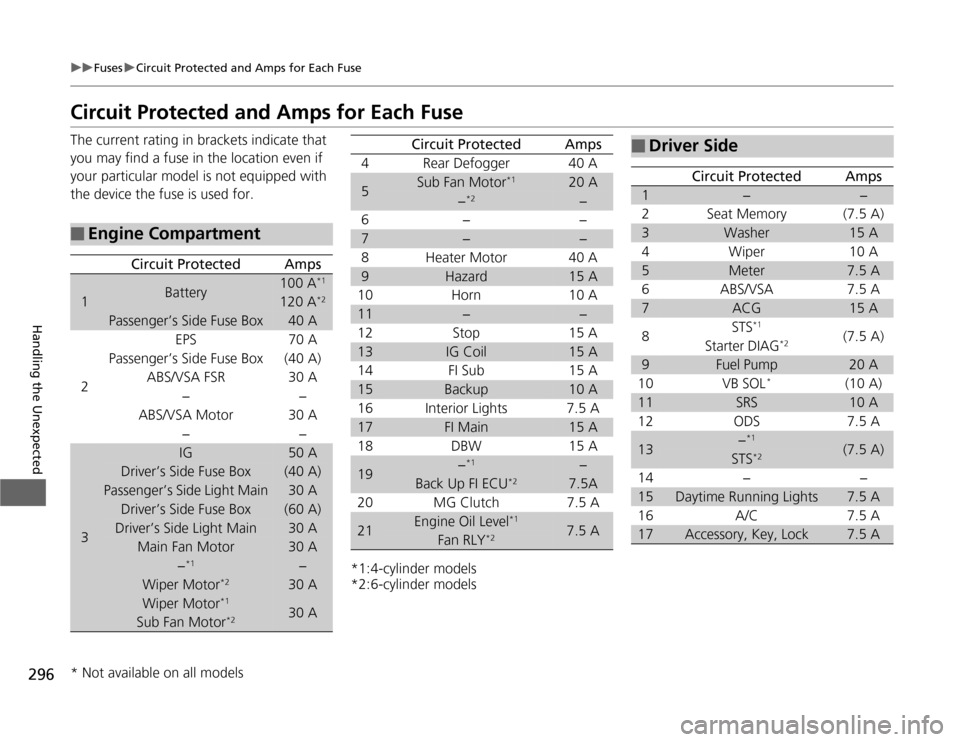
296
uuFusesuCircuit Protected and Amps for Each Fuse
Handling the Unexpected
Circuit Protected and Amps for Each FuseThe current rating in brackets indicate that
you may find a fuse in the location even if
your particular model is not equipped with
the device the fuse is used for.■
Engine Compartment
Circuit Protected
Amps
1
Battery
100 A
*1
120 A
*2
Passenger’s Side Fuse Box
40 A
2
EPS
70 A
Passenger’s Side Fuse Box (40 A)
ABS/VSA FSR
30 A
−−
ABS/VSA Motor
30 A
−−
3
IG
50 A
Driver’s Side Fuse Box
(40 A)
Passenger’s Side Light Main
30 A
Driver’s Side Fuse Box
(60 A)
Driver’s Side Light Main
30 A
Main Fan Motor
30 A
−*1
−
Wiper Motor
*2
30 A
Wiper Motor
*1
30 A
Sub Fan Motor
*2
*1:4-cylinder models
*2:6-cylinder models4 Rear Defogger 40 A5
Sub Fan Motor
*1
20 A
−*2
−
6− −
7
−
−
8 Heater Motor 40 A
9
Hazard
15 A
10 Horn 10 A
11
−
−
12 Stop 15 A
13
IG Coil
15 A
14 FI Sub 15 A
15
Backup
10 A
16 Interior Lights 7.5 A
17
FI Main
15 A
18 DBW 15 A
19
−*1
−
Back Up FI ECU
*2
7.5A
20 MG Clutch 7.5 A
21
Engine Oil Level
*1
7.5 A
Fan RLY
*2
Circuit Protected
Amps
■
Driver Side
Circuit Protected
Amps
1
−
−
2
Seat Memory
(7.5 A)
3
Washer
15 A
4
Wiper
10 A
5
Meter
7.5 A
6
ABS/VSA
7.5 A
7
ACG
15 A
8
STS
*1
(7.5 A)
Starter DIAG
*2
9
Fuel Pump
20 A
10
VB SOL
*
(10 A)
11
SRS
10 A
12
ODS
7.5 A
13
−*1
(7.5 A)
STS
*2
14
−
−
15
Daytime Running Lights
7.5 A
16
A/C
7.5 A
17
Accessory, Key, Lock
7.5 A
* Not available on all models
Page 298 of 324

297
uuFusesuCircuit Protected and Amps for Each Fuse
Handling the Unexpected
*1:4-cylinder models
*2:6-cylinder models18
Accessory
7.5 A
19
Driver’s Power Seat Sliding
(20 A)
20
Moonroof
(20 A)
21
Driver’s Power Seat
Reclining
(20 A)
22
Rear Driver’s Side Power
Window
20 A
23
Front Accessory Power
Socket
20 A
24
Driver’s Power Window
20 A
25
Driver’s Side Door Lock
15 A
26
Left Front Fog Light
(10 A)
27
Left Side Small Lights
(Exterior)
10 A
28
Left Headlight High Beam
10 A
29
TPMS
10 A
30
Left Headlight Low Beam
15 A
31
−
−
32 Engine Oil Level
*
(7.5 A)
Circuit Protected
Amps
■
Passenger Side
Circuit Protected
Amps
1
Right Headlight High Beam
10 A
2
Right Side Small Lights
(Exterior)
10 A
3
Right Front Fog Light
(10 A)
4
Right Headlight Low Beam
15 A
5
−
−
6
Interior Lights
7.5 A
7
−
−
8
Passenger’s Side Power Seat
Reclining
20 A
9
Passenger’s Side Power Seat
Sliding
20 A
10
Right Side Door Lock
10 A
11
Rear Passenger’s Side Power
Window
20 A
12
Console Accessory Power
Socket
20 A
13
Front Passenger’s Power
Window
20 A
14
−
−
15
Premium AMP
(20 A)
16
−
−
17
−
−
18
−
−
19
Seat Heater
20 A
20
−
−
21
−
−
22
−
−
Circuit Protected
Amps
* Not available on all models
Page 299 of 324
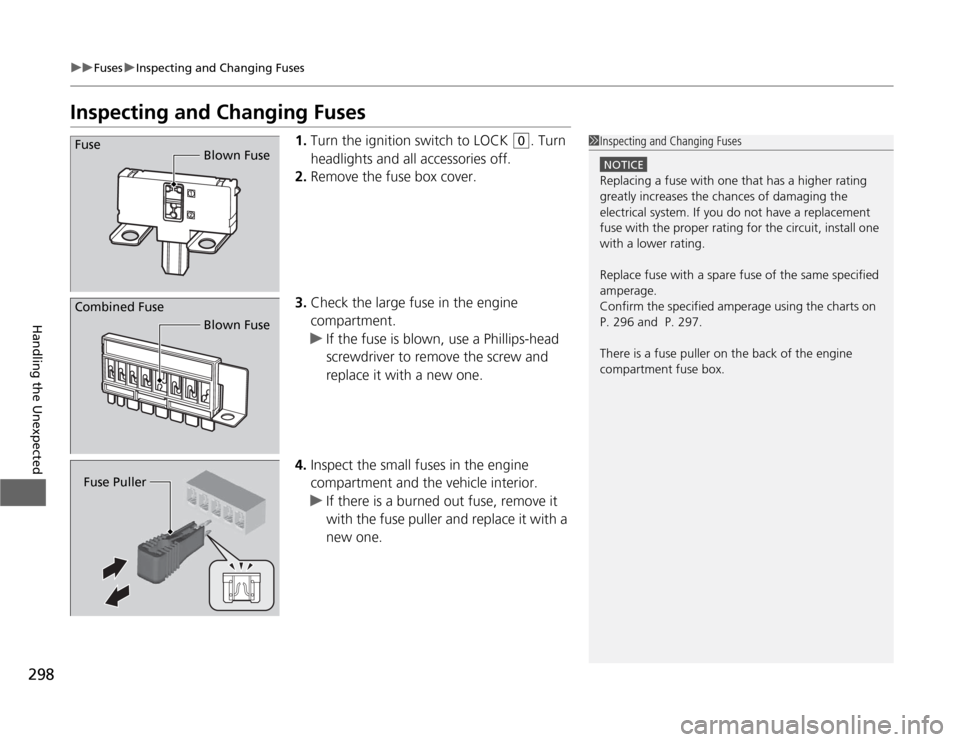
298
uuFusesuInspecting and Changing Fuses
Handling the Unexpected
Inspecting and Changing Fuses
1.Turn the ignition switch to LOCK
(0
. Turn
headlights and all accessories off.
2.Remove the fuse box cover.
3.Check the large fuse in the engine
compartment.
uIf the fuse is blown, use a Phillips-head
screwdriver to remove the screw and
replace it with a new one.
4.Inspect the small fuses in the engine
compartment and the vehicle interior.
uIf there is a burned out fuse, remove it
with the fuse puller and replace it with a
new one.
1Inspecting and Changing Fuses
NOTICEReplacing a fuse with one that has a higher rating
greatly increases the chances of damaging the
electrical system. If you do not have a replacement
fuse with the proper rating for the circuit, install one
with a lower rating.
Replace fuse with a spare fuse of the same specified
amperage.
Confirm the specified amperage using the charts on
P. 296 and P. 297.
There is a fuse puller on the back of the engine
compartment fuse box.
Fuse
Blown FuseCombined Fuse
Blown FuseFuse Puller
Page 300 of 324
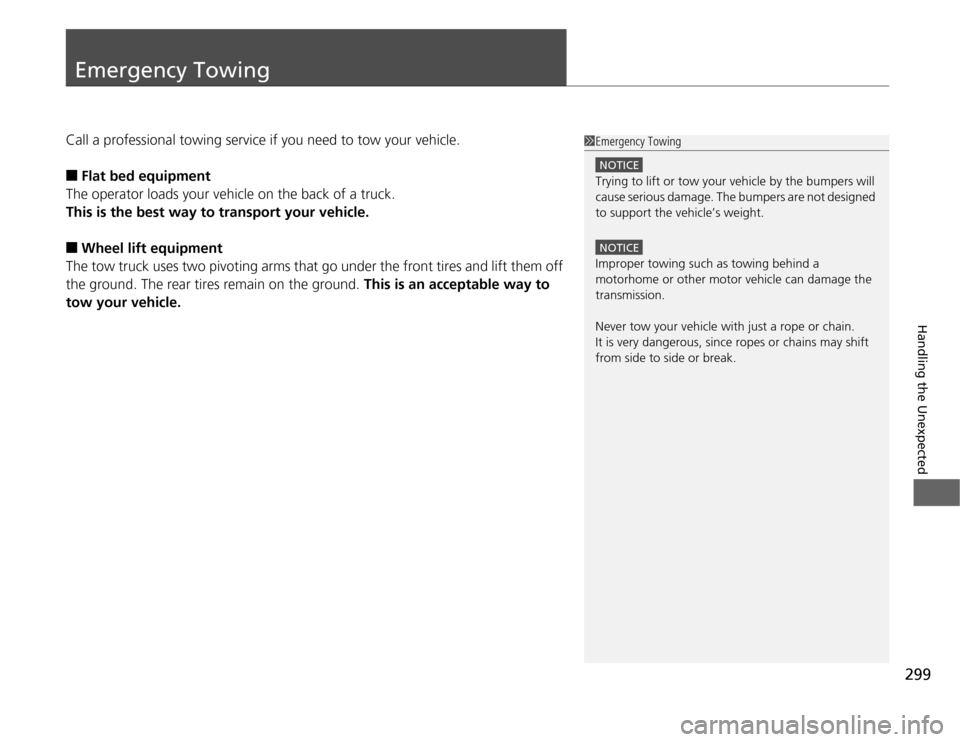
299
Handling the Unexpected
Emergency TowingCall a professional towing service if you need to tow your vehicle.■
Flat bed equipment
The operator loads your vehicle on the back of a truck.
This is the best way to transport your vehicle.
■
Wheel lift equipment
The tow truck uses two pivoting arms that go under the front tires and lift them off
the ground. The rear tires remain on the ground. This is an acceptable way to
tow your vehicle.
1Emergency Towing
NOTICETrying to lift or tow your vehicle by the bumpers will
cause serious damage. The bumpers are not designed
to support the vehicle’s weight.NOTICEImproper towing such as towing behind a
motorhome or other motor vehicle can damage the
transmission.
Never tow your vehicle with just a rope or chain.
It is very dangerous, since ropes or chains may shift
from side to side or break.